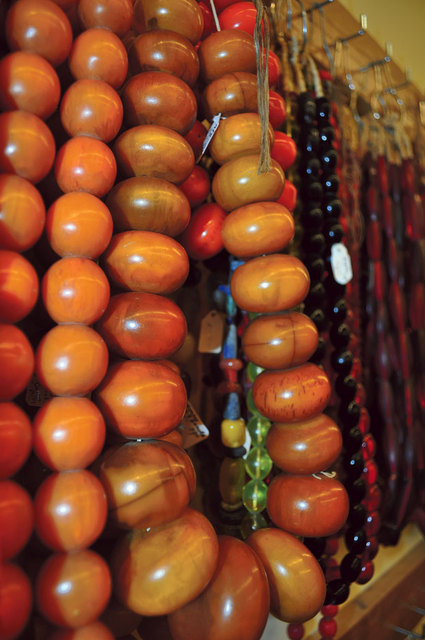“We have a lot of weird stuff," says owner Robert Steinberg.
Islamic and Buddhist prayers beads hang next to gold-foil-infused ones from China. They come in stone, metal, plastic, shells; almost any material imaginable. Sand-cast beads are made from recycled glass. Others are carved out of wood or made from seeds. Inside a glass case sit Japanese ojime beads; a carved wooden Komodo dragon lounges next to stone frogs. Strands of gemstones—turquoise, amethyst, fluorite—hang from a wall, along with fresh-water pearls and heishi beads.Steinberg jokes that two traits that make humans human, regardless of where they’re from, are using tools and wearing beads. Fittingly, he estimates that Stone Mountain sources from about 60 countries. There’s
lapis from Afghanistan, amber from Poland and malachite from Zaire. Steinberg knows the origins of every strand.For instance, vintage “African amber” was one of the first uses of plastic, employed as an easy way to con people into trading for more valuable stuff. They now command a princely sum. Stone Mountain works with several African traders, and a significant amount of its stock comes from the continent.
Steinberg says he got his start a lot closer to home, however, by selling Native American jewelry when it was all the rage in the ’70s. “It was big,” he says. “Every time you turned on
Johnny Carson, the guest was wearing a concho belt and a squash blossom.”The market eventually flooded, so he got out. In the ’80s he traveled extensively, mostly in Asia. Steinberg saw that people were making silver jewelry much like what he traded in the previous decade, just using different stones. He gradually began getting into beads.
“I had people buying garnet rings; why not garnet beads?” he asks.
Steinberg opened Stone Mountain when he came back to Albuquerque. The gallery has been around since 1993, inhabiting several locations around Nob Hill. Stone Mountain came to its current spot in 2009. Steinberg is banking on the success of “upper Nob Hill,” as he calls it. “I feel like it’s a longterm investment,” he says. “I think it’s really going to take off.”
Steinberg says a common misconception of the gallery is that it only showcases beads. He still has loads of “cheap, good jewelry” he bought when he was a wholesaler. Though the price of silver has quadrupled, Steinberg says he sells silver pieces below market cost. Since his background is in jewelry, he also likes to pick up pieces from designers who off-load last season’s stock.
Even with so many beautiful objects to sort through, there’s one design theme that New Mexicans can’t get enough of:
skulls. “We’ve got about 60 kinds of skulls," Steinberg says, crediting their popularity to holidays like El Día de los Muertos. "And grandmas come in and buy them,” he adds. “It’s not just teenaged boys.”“He smelled like alcohol. So we knew it wasn’t the real Santa, because Santa doesn’t drink alcohol.”—9-year-old Katie Dockerty talking to reporters for WEAU-TV in Eu Clair, after an intoxicated 55-year-old Thomas Arnold stumbled into the Dockerty family yard wearing a red suit and beard and looking for his “lost reindeer.”
Stone Mountain Bead Gallery4008 Central SEOpen daily 1 to 6 p.m., and noon to 4 p.m. Sundays260-1121











